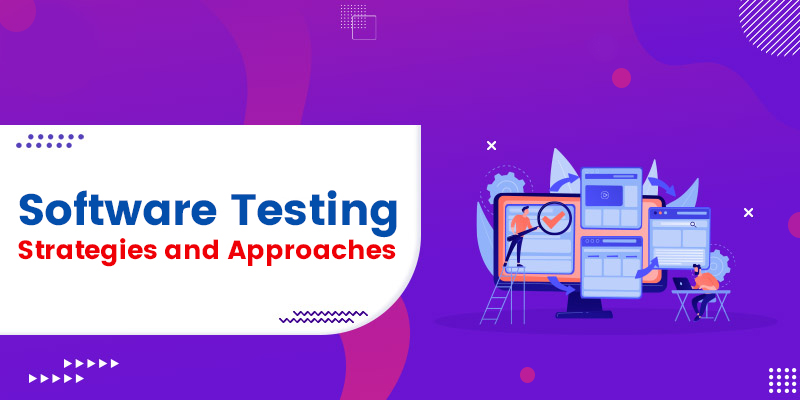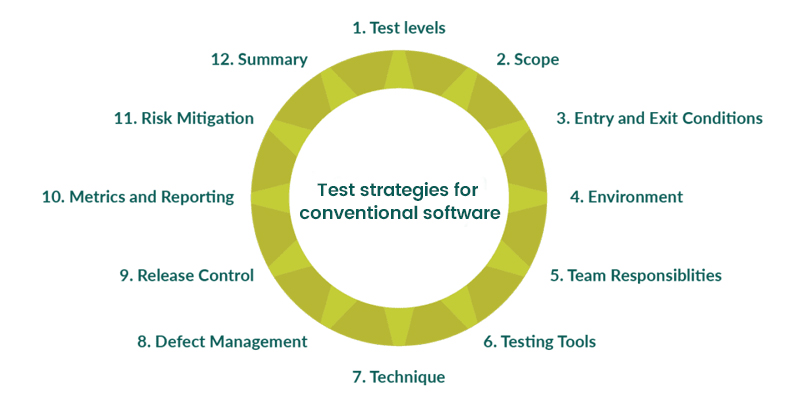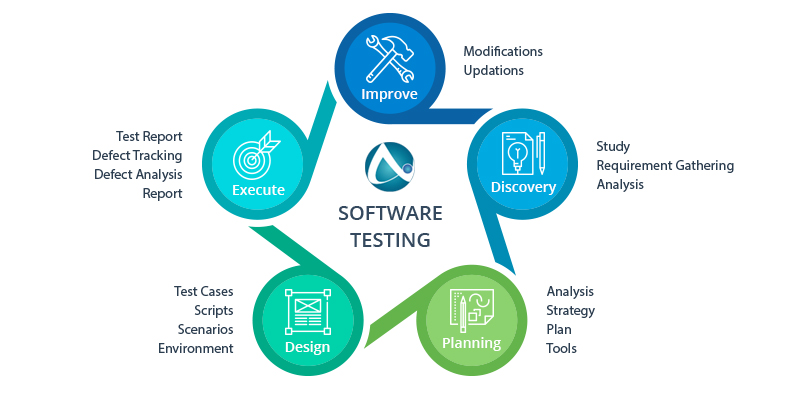
Strategic planning, which outlines the goals, objectives, and methodology, serves as the foundation for effective software testing. It entails determining the scope of testing, establishing appropriate testing procedures, and outlining the resources and timescales required. A solid plan ensures that testing efforts are aligned with the project's objectives and that any risks and problems are mitigated. When embarking on a software testing project, it is vital to prioritize strategy and investment. A well-defined strategy is required to determine the methodologies and tools required for testing a website or application. Assessing the whole project investment is easier with a clear approach. As a result, in this blog, we will look at software testing methodologies and approaches. You may learn about various software testing methodologies by enrolling in FITA Academy's Software Testing Course In Chennai.
Testing Strategies and its types

Software testing strategies are comprehensive approaches that guide the testing process and ensure effective and efficient testing of software applications. There are four types of Testing strategies. Here are some commonly used software testing strategies:
- Static Testing Strategy
- Structural Testing Strategy
- Behavioral Testing Strategy
- Front-End Testing Strategy
Static Testing Strategy
A static test assesses the quality of a system without executing the system, which may initially appear challenging. However, there are several strategic approach to software testing available to achieve this evaluation.
- Static testing involves analyzing specific portions or elements of a system to identify potential issues at an early stage. One example is desk-checking, where developers review their code before pushing it, serving as a form of static testing. Another example is conducting review meetings to assess requirements, design, and code.
- Static tests provide significant advantages by detecting problems in requirements before they manifest as system bugs, resulting in time and cost savings. Additionally, conducting a preliminary code review helps identify bugs without the need to build, install, and run the entire system.
- Timing is a vital aspect of static tests. Reviewing requirements after developers have completed coding the software can assist testers in designing effective test cases. However, it is important to note that testers can only identify bugs in existing code by executing the system, thus undermining the purpose of static tests. In such cases, individual developers should review the code promptly after creation and before integration.
- Organizations can enhance software quality, mitigate risks, and optimize the overall development process by implementing comprehensive static testing practices at appropriate stages.
Structural Testing Strategy
Although static tests provide valuable insights, they need to be more comprehensive. Executing the software on real devices and running the entire system to ensure comprehensive bug detection is essential. Unit testing, including structural tests, is employed to achieve this objective.
- White-box testing, also known as clear-box testing or structural testing in software testing, is conducted by testers with extensive knowledge of the devices and systems under evaluation.
- This testing approach is frequently employed to scrutinize specific components and interfaces, aiming to pinpoint and rectify localized errors within data flows. To gain practical expertise in Software Testing, consider enrolling in a Software Testing Online Course. These courses offer comprehensive training, and enable learners to master in Software Testing.
Behavioral Testing Strategy
Behavioral Testing, or black-box testing, centers around the system's behavior rather than its underlying mechanisms. It emphasizes workflows, configurations, performance, and all aspects of the user journey. The main objective of these tests is to assess a website or app from an end-user perspective.
- Behavioral Testing should encompass multiple user profiles and diverse usage scenarios.
- It primarily focuses on evaluating fully integrated systems rather than individual components. This approach allows for a comprehensive assessment of system behavior from the user's perspective, which becomes evident only when the system is sufficiently assembled and integrated.
- While behavioral tests are predominantly executed manually, certain aspects can be automated.
- Manual testing requires meticulous planning, thoughtful design, and thorough result verification to identify potential issues.
- Automation testing streamlines repetitive actions, such as regression tests, ensuring that new code implementations do not disrupt existing functioning features. For instance, when testing a website, automating the process of filling in multiple form fields with various values can significantly save time, effort and mitigate human error.
Front-End Testing Strategy
The front end of an application pertains to its user-facing component, serving as the primary interface for content consumption and business transactions. Front-end is one of the software testing strategies that plays a vital role in the software development life cycle (SDLC) by ensuring the proper functioning of GUI elements. We can break them into the following categories of software testing types and approaches:
- Unit Testing: Unit Testing is the initial layer integrated into the codebase, focusing on running test functions before the application is built to assess individual processes and modules.
- Functional Testing: Functional testing involves manually evaluating features and components through a user interface, typically using mock data.
- Integration Testing: Integration testing involves connecting front-end components with back-end services to ensure seamless integration from client inputs, through APIs, to database management within a dedicated test environment.
- System/UI Testing: System/UI testing occurs once a test version of the user interface has been successfully integrated with the back-end service, enabling automated testing and analysis conducted by developers in collaboration with the QA team.
- Performance/Load Testing: Performance/load testing verifies the application's ability to handle the expected load and scale, considering optimal usage scenarios.
- Stress/Security Testing: Stress/Security Testing validates the application's response under unexpected loads and threats beyond the expected limit.
- Accessibility Testing: Accessibility testing ensures that individuals with disabilities can effectively utilize the application.
These software testing strategies can be adapted and combined based on project requirements, development methodologies, and the specific characteristics of the software application. The selection of an appropriate testing strategy depends on factors such as the software's complexity, time constraints, available resources, and the desired level of quality assurance. By enrolling in the Best Software Testing Institute in Bangalore, learners can gain knowledge and a comprehensive understanding of the concepts of Software Testing. The training program offers extensive guidance, enabling participants to effectively grasp the core principles of Software Testing.
Test strategies for Conventional Software

Test strategies for conventional software are systematic approaches employed to ensure effective testing of traditional software applications. These strategies outline the overall approach, goals, and techniques to be utilized during the testing process. Some commonly used test strategies for conventional software include:
- Requirement-based Testing: Requirement-based Testing is a strategy that focuses on verifying whether the software meets the specified requirements. Test cases are designed based on the documented requirements, and the software is evaluated against these requirements to ensure compliance.
- Functional Testing: Functional Testing strategy aims to validate the functional aspects of the software by testing individual functions or features. It involves designing test cases to exercise different functionalities and verifying that the software performs as intended.
- Integration Testing: Integration testing involves testing the interaction and integration between various software components or modules. It ensures that different components work together seamlessly and accurately to exchange data.
- System Testing: System testing is conducted to validate the entire software system. It includes testing all integrated components and subsystems to ensure they function correctly and meet the overall system requirements.
- Performance Testing: This strategy evaluates the software's performance under specific conditions, such as load, stress, or scalability. It aims to identify performance bottlenecks, measure response times, and ensure the software can handle expected workloads.
- Regression Testing: This testing is one of the software testing strategies that focuses on retesting previously tested functionalities to ensure that recent changes or fixes have not introduced new defects or caused any unintended side effects.
- User Acceptance Testing (UAT): UAT is performed by end-users or representatives to verify whether the software meets their expectations and requirements. It ensures the software is ready for deployment and use in a real-world environment.
- Security Testing: The security Testing strategy aims to identify vulnerabilities and ensure the software's resistance against potential security threats. It includes testing for authentication, authorization, data encryption, and protection against common security attacks.
- Usability Testing: Usability testing assesses the software's user-friendliness, ease of use, and overall user experience. It evaluates interface design, navigation, and user interaction to ensure optimal usability.
- Maintenance Testing: Maintenance testing is performed after software updates or modifications to ensure that the changes have not introduced new defects or adversely affected existing functionalities. To see how Software Testing might be used, join the Software Testing Course in Coimbatore and learn the various applications and their functionalities.
How should we choose from different Software Testing Strategies?
A strategic approach to software testing involves a well-planned and structured methodology to ensure effective testing and quality assurance throughout the software development lifecycle. Here are the key elements of a strategic approach to software testing:
- Risk Assessment: It is important to evaluate the risks associated with testing carefully. Consider the possibility of tests disrupting the functioning of the software. For instance, when testing new features or updates of an established app in the digital market, there is a risk of crashes or unintended scrambling of existing features. In such cases, testers may need to adopt regression-averse strategies to mitigate potential risks.
- Objective Alignment: The testing strategy should align with the requirements and expectations of the stakeholders. It is crucial to ensure that the tests assess the functionality of all software features, meet the business requirements, and deliver genuine benefits to the users.
- Compliance with Regulations: Verifying that the software being tested complies with all relevant regulations applicable to its industry and the digital domain is vital. Different geographical regions may have varying regulations that the same app or website must adhere to. Testers should know local regulations to ensure the software remains compliant and does not unintentionally violate laws.

In conclusion, adopting effective software testing strategies and approaches is on the rise to ensure the delivery of high-quality software products. Organizations can systematically verify and validate software functionalities, identify defects, and mitigate risks throughout the development lifecycle by employing a well-planned and structured methodology. From comprehensive test planning to strategic test design, execution, and automation, each step is crucial in achieving optimal testing outcomes. Moreover, continuous improvement, incorporating feedback, and embracing industry best practices created a culture of excellence in software testing. Organizations can systematically verify and validate software functionalities, identify defects, and mitigate risks throughout the development lifecycle by employing a well-planned and structured methodology. If you are seeking Software Testing courses, FITA Academy offers the best Software Testing Course in Pondicherry, providing comprehensive training to enhance your skills in this field.
